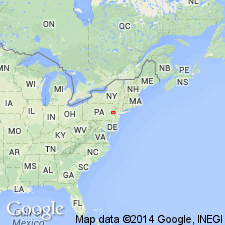
- Usage in publication:
-
- Maskenozha Member*
- Modifications:
-
- Named
- Dominant lithology:
-
- Shale
- Limestone
- AAPG geologic province:
-
- Appalachian basin
Summary:
Pg. 2 (fig. 1), 33-34, 55-57, 63-65, pl. 1. Maskenozha Member of New Scotland Formation of Helderberg Group. Consists of dark-gray siliceous laminated shale beds that weather medium-gray. Medium-dark-gray dense limestone pods as much as 1 foot wide and 0.8 foot thick, as well as scattered beds and lenses of medium-gray fine-grained argillaceous limestone as much as 1 foot thick, occur 20 to 30 feet above base. Member present in New Jersey, New York, and Pennsylvania. Persists to southwest end of Godfrey Ridge in Saylorsburg quadrangle. Very poorly exposed; forms covered slopes in New Jersey and northern Pennsylvania, complete sections unknown in southeastern New York. Thickness 23 feet at type section. Estimated total thickness in area of type section 43 to 48 feet. Overlies Flatbrookville Member (new); contact varies from abrupt to gradational and is placed at highest occurrence of abundant dark-gray chert and abundant pure limestone beds characteristic of the Flatbrookville, and below the dark-gray laminated shales of the Maskenozha. Underlies Minisink Limestone (new); contact is abrupt or gradational and is characterized by change from shale having some argillaceous limestone beds in the Maskenozha to argillaceous limestone in the Minisink. Is abundantly fossiliferous, but has less diverse fauna than Flatbrookville. Brachiopods, bryozoans, corals, crinoid columnals, ostracodes, and trilobites are common. Brachiopod MACROPLEURA MACROPLEURA occurs throughout. Age is Early Devonian. Report includes measured sections. (Maskenozha Member of New Scotland Formation of Helderberg Group adopted by the USGS.)
Type section: about 3.5 mi northeast of Flatbrookville, in woods and along northeast side of Flatbrookville-Wallpack Center Road, 3.2 mi (road distance) from intersection with Trans-Kittatinny Road joining it from the southeast, near southern edge of Lake Maskenozha 7.5-min quadrangle [approx. Lat. 41 deg. 7.7 min. N., Long. 74 deg. 54.86 min. W., Sussex Co., NJ (A.G. Harris, written commun., ca. 1995)]. Named from Lake Maskenozha, PA, 5.5 mi to northwest.
Reference section: on northeast bank of Brodhead Creek at Minisink Hills, in northeast corner of Stroudsburg quadrangle [approx. Lat. 40 deg. 59.67 min. N., Long. 75 deg. 9.00 min. W., Monroe, Co., PA (A.G. Harris, written commun., ca. 1995)].
Source: Publication; US geologic names lexicon (USGS Bull. 1350, p. 474); GNU records (USGS DDS-6; Reston GNULEX); Changes in stratigraphic nomenclature, 1967 (USGS Bull. 1274-A, p. A13).
For more information, please contact Nancy Stamm, Geologic Names Committee Secretary.
Asterisk (*) indicates published by U.S. Geological Survey authors.
"No current usage" (†) implies that a name has been abandoned or has fallen into disuse. Former usage and, if known, replacement name given in parentheses ( ).
Slash (/) indicates name conflicts with nomenclatural guidelines (CSN, 1933; ACSN, 1961, 1970; NACSN, 1983, 2005, 2021). May be explained within brackets ([ ]).

